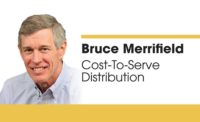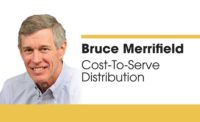Bruce Merrifield: Pink Kit Kats vs. niche domination

On Jan. 18, after 10 years of development, Nestle rolled out Ruby chocolate Kit Kats in Korea and Japan just in time for Valentine’s Day.
The pink Kit Kat, made from the Ruby cocoa bean, will make premium a line that has hundreds of flavors, including green tea and strawberry.
Asian distributors will race to be the first to market with the pink Kit Kat, but will greater consumption of the Kit Kat line result? What sustainable edge and profits will distributors get from Nestle’s promotional bribes and intensive distribution policy?
In 2018, how many U.S. distributors across channels also will be racing to market with new micro-niche products within non-exclusive lines? And for what sustainable gains?
Another option: Better service value to key accounts
Here is a case study that shows another approach, one that may be more realistic for a majority of distributors. A distributor with 2017 sales of $18 million and operating profit of $300,000 (1.67%) recently subscribed to a customer profitability analytics cloud service that gave it new insights into its most profitable customer segments. The distributor found its most profitable segments accounted for:
5% of all customers;
$6 million in sales;
$1.3 million in profit;
The top 8 customers yielded $1 million of the segment’s profits; and
The bottom two lost $130,000.
In addition, the company discovered 28% of all accounts generated profits of $3.2 million to pay for the $2.9 million in losses from the other 72%. It also just discovered big cross-subsidy opportunities.
Thoughts about this and your No. 1 niche
What can you take away from the case-study company’s learning? There are many questions you can be asking about your own business. First, losing a top-10-profitbale account would hurt. How can you better keep them, get more share of their business and lower replenishment costs for both parties?
What is the root causes for the big profit/loss differences in the top and bottom of your big accounts? To find out, take a visit to the top six and the bottom two customer locations to investigate the efficiency of and upside effectiveness potential for replenishment and utilization processes. You also can look for more precise service metrics and potential extra services common to the niche.
Who will do this research? And could your company execute on new research findings? Other distributors, who have used this CPA method, can claim typical success story results of a 50% to 100% increase in niche sales and more in profits. And that’s just in the first year.
The most important question may be, “What if a competitor did this drill on your No. 1 niche first?”
Can you make this happen at your firm? Or are you too busy doing routine activities such as product promotions on nonexclusive vendors’ so-called new stuff or servicing losing orders from a sea of losing, minnow customers.
Reinvent your service value for your most profitable customers and niches. You will grow sales, profits and rebates far more than with new, commodity rollouts. When will you start niche domination?
Looking for a reprint of this article?
From high-res PDFs to custom plaques, order your copy today!






